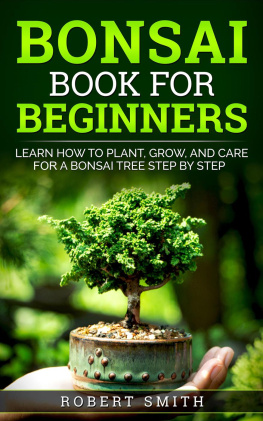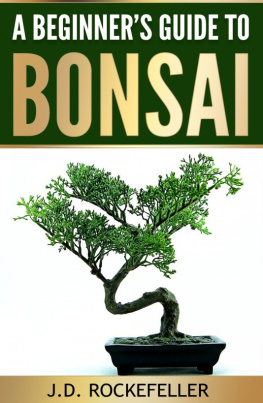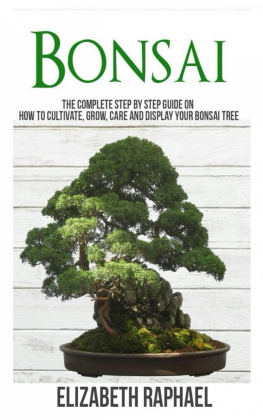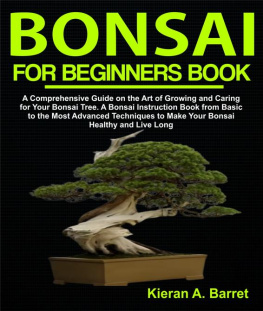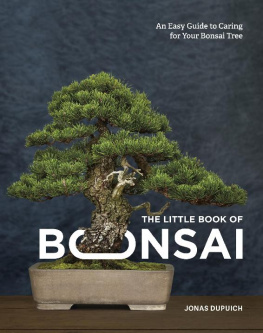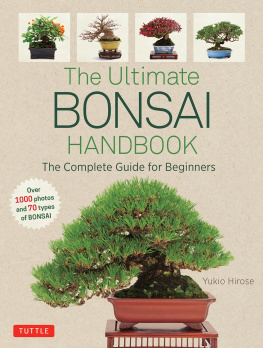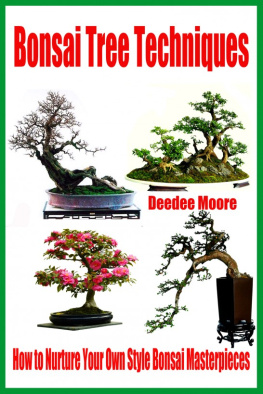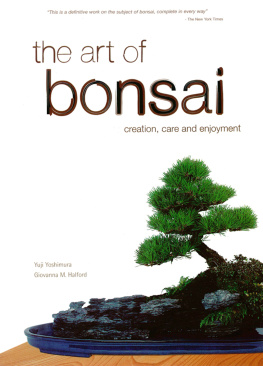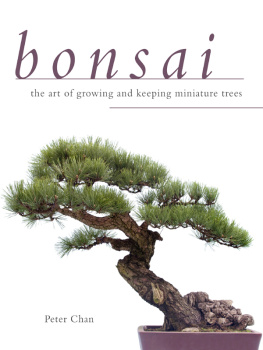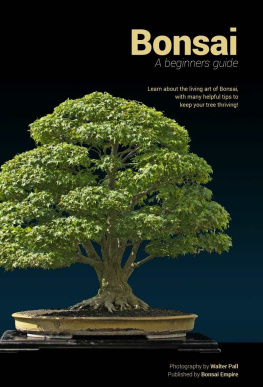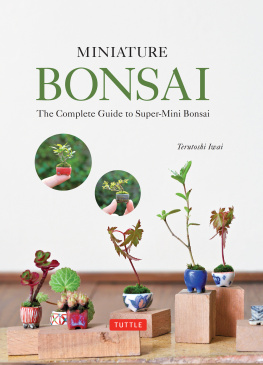Bonsai Book for Beginners
Learn How to Plant, Grow, and Care for a Bonsai Tree Step by Step
Copyright Robert Smith - All rights reserved.
The content contained within this book may not be reproduced, duplicated or transmitted without direct written permission from the author or the publisher.
Under no circumstances will any blame or legal responsibility be held against the publisher, or author, for any damages, reparation, or monetary loss due to the information contained within this book, either directly or indirectly.
Legal Notice:
This book is copyright protected. It is only for personal use. You cannot amend, distribute, sell, use, quote or paraphrase any part, or the content within this book, without the consent of the author or publisher.
Disclaimer Notice:
Please note the information contained within this document is for educational and entertainment purposes only. All effort has been executed to present accurate, up to date, reliable, complete information. No warranties of any kind are declared or implied. Readers acknowledge that the author is not engaged in the rendering of legal, financial, medical or professional advice. The content within this book has been derived from various sources. Please consult a licensed professional before attempting any techniques outlined in this book.
By reading this document, the reader agrees that under no circumstances is the author responsible for any losses, direct or indirect, that are incurred as a result of the use of the information contained within this document, including, but not limited to, errors, omissions, or inaccuracies.
Table of Contents
Y ou are going to have a tree in your house.
That is unless you already have a bonsai, in which case, you already have a tree in your house. And yes, a bonsai is a tree, much like what you see in the forests, your backyard, or in the woods. Some people like to call them plants due to their small stature, and thats okay too. Whatever you think they are, what really matters is what the bonsai helps to create in your room or wherever they are placed: a sense of beauty and awe.
If you ask me why I consider them trees, it has everything to do with the general anatomy of a tree. At the most foundational level, a tree consists of a crown, a trunk, and roots. A bonsai has a similar foundation. It is still quite difficult to pinpoint exactly what makes a bonsai a bonsai, which is why many people think of them as miniature trees. As I mentioned earlier, it is okay to think of them as plants as well.
However, they are not grown in the same way that you would a typical plant or an herb. It isnt simply about planting seeds, watering them, and giving them the occasional sunlight. There is more to growing a bonsai tree, which you can understand when you look at the result: a beautiful addition to your home that is quite frankly something no other plant or ornament can provide. Plus, they live for a very long time.
Oh yes, a bonsai tree has a long life. A common misconception is that since bonsai trees are so small, their physical stature reflects their lifespan. Reality presents a scenario that is quite the contrary. Did you know that the Ficus tree carefully maintained in the Crespi Bonsai Museum is over 1,000 years old? Pretty amazing, isnt it? Bonsai trees may actually outlive us and our children, and their children as well.
The bonsai trees unique presentation and attractiveness has allowed them to spread out from the land of the rising sun, and into many countries around the world. Today, bonsai is not something you see just in Japan. In fact, there is even a nonprofit organization called National Bonsai Foundation that showcases bonsai creations of people across the U.S. The foundation is located in northwest Washington D.C., at the US National Arboretum, and its exhibits attract over 200,000 people every year. Some of you might have already heard of the foundation. Others who are new to the world of bonsai might be wondering, Hold on just a minute. Is bonsai that popular? I thought it would be an activity only a few hundred maybe a couple of thousand people would be involved in. Not true at all. You would be surprised at the number of people who are part of the bonsai phenomenon.

Image: A bonsai is a beautiful addition to your home.
B onsai popularity has reached a level where people have developed their own methods to grow the trees that are slightly different from the Japanese system. This does not mean that the way the trees are grown in Japan is inferior in quality or in approach. Rather, the fact that people have developed their own methods for growing the trees shows a passion for the art of bonsai.
So lets plant our roots into the world of bonsai, raise our crowns of knowledge, and shake our trunks in anticipation (somehow, that last bit didnt come out the way I intended it to).
It is time to plant our understanding with this bonsai care basic guide.
Chapter 1
The History and Tradition of Bonsai
T here is more to bonsai than meets the eye. But to truly grasp the attention and love that these miniature trees are garnering around the world, it is important to pull back the curtains of history. When we comb through the rich past of bonsai, we begin to uncover a craft that contains an incredible depth to its philosophy. There is so much we can learn about the hobby. To begin with, lets go back to circa 1,000 BC.
A Miniature History Lesson
W hen people think of bonsai, they often think of Japan. However, some historians believe that the art of miniature tree making had its origins in a much larger country: China. The method of growing trees indoors was perfected by Buddhist monks: their goal was to bring a slice of nature to the indoors. Raising plants was common around the world, which made the monks wonder if there was a way to bring a tree indoors. But if they did, then they wanted to make it small enough to fit inside a room.
When you examine ancient manuscripts and paintings, you can begin to understand the full extent of the passion that the Chinese had for cultivating trees in containers that were unique and, most importantly, artistic.
Next page
